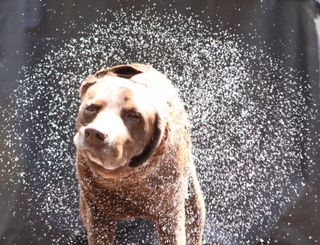
How Dogs Shake Dry in One Second

Next time the family dog bounds out of the nearest body of water and shakes itself off right beside you, don't get irritated: You're witnessing a feat of evolution that engineers can only dream of re-creating.
Furry mammals can shake themselves 70 percent dry in just a fraction of a second, according to new research. The study, which looked at the shaking speeds of 16 species of mammals, from mice to lions to bears, found that the smaller the animal, the faster it must shake to dry its fur.
"We think this has been evolving over millions of years of time to become so good," said study researcher David Hu, who studies biolocomotion at Georgia Tech. "Imagine if you could come out of the shower and, instead of using a towel, you could just press a button and in one-thirtieth of a second you're 70 percent dry."
The findings could provide inspiration for self-cleaning and self-drying robotics, Hu told LiveScience. [Video: Watch the Animals Shake Dry in Slow-Motion]
Shaking to survive
For mammals, drying off is a matter of life and death, Hu said. A relatively hairless human emerging from a bath can carry up to a pound of water on his or her body. An immersed rat will emerge with 5 percent of its body mass in water clinging to its fur. And a wet ant can find itself staggering under three times its body weight in liquid. (Hu previously studied how mosquitoes can survive direct hits by raindrops during a storm.)
Drying off quickly is particularly critical in winter. Hu and his colleagues calculate that a 60-pound dog with a pound of water on its fur would use a full 20 percent of its daily caloric intake staying warm as it air-dried.
Sign up for the Live Science daily newsletter now
Get the world’s most fascinating discoveries delivered straight to your inbox.
"Imagine you fell into the lake in the winter and had wet clothes all around you and couldn't dry," Hu said.
Water would also be a challenge for autonomous robots that traipse around outdoors. Dust poses similar problems for electronics, Hu noted, citing NASA's Mars rovers. Modern Earthbound electronics often include internal shakers to dislodge dust, he said.
To find out how biology solved the self-cleaning problem, Hu and his colleagues went to the zoo and the park, as well as to the lab. They measured body sizes and shake speeds in 33 mammals from 16 species, ranging from guinea pigs and tiny juvenile mice to bears and lions. They also tested five breeds of dog.
"My graduate student had the pleasure of dousing them with a hose and measuring the frequency" of their shakes, Hu said, adding that no animals were harmed beyond momentary dampness in the process of the study.
To test drying speeds, the researchers also set up a "wet-dog simulator," a device that shook tufts of wet fur.
Shake it up
The researchers found that the bigger the animal, the slower it could shake to dry off. That's because the fur of a large animal shaking travels farther and is subject to more centripetal force than the fur of a small animal shaking. Centripetal forces are those that move an object in a circle. It's a bit like being on a merry-go-round: If you're at the edge of the merry-go-round, you're subject to greater force than if you're at the center.
So while a bear shakes about four times a second and a typical dog shakes four to six times per second to dry off, mice and rats have to move up to 10 times as quickly, the research revealed.
"They have to shake 30 times per second, which is unimaginable because their whole body is whipping back and forth," Hu said.
The researchers also found that loose skin helped the drying process immensely, because the extra movement resulted in nine times the force than if the skin were tight. That could explain why hairy mammals tend to have some give in their skin, Hu said. [10 Things You Didn't Know About Dogs]
No matter their size, all of the mammals were about as efficient as possible at drying off quickly, Hu said.
"I don't think we're going to make a Mars rover in the shape of a dog or anything like that," he said. "But if people can think about how animals do this so quickly, they'll get an idea of what is possible."
Follow Stephanie Pappas on Twitter @sipappas or LiveScience@livescience. We're also on Facebook &Google+.

Stephanie Pappas is a contributing writer for Live Science, covering topics ranging from geoscience to archaeology to the human brain and behavior. She was previously a senior writer for Live Science but is now a freelancer based in Denver, Colorado, and regularly contributes to Scientific American and The Monitor, the monthly magazine of the American Psychological Association. Stephanie received a bachelor's degree in psychology from the University of South Carolina and a graduate certificate in science communication from the University of California, Santa Cruz.
